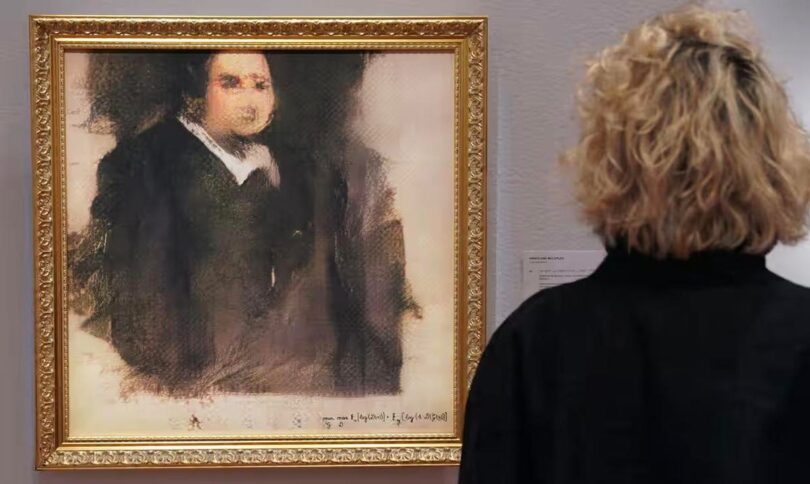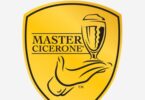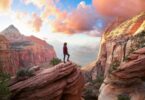Woman at Christie’s New York views Edmond de Belamy, from La Famille de Belamy generative … [+]
The face and upper body of a stout man with dark hair, wearing a black jacket with a white collar suggesting he may be an ecclesiastic, is obscured. It appears to be a work in progress from the 18th-century, with exposed naked canvas.
The wall placard identifying the male sitter as Edmond de Belamy was easy to decipher, but the artist’s name is shrouded in more mystery than the seemingly unfinished composition. We look closely to decode the signature in cursive Gallic script on the bottom right corner: “min G max D x [log (D(x))] + z [log (1 -D (G(z)))]”.
The global art world gasped when the General Adversarial Network (GAN) print on canvas, created by a Paris-based art collective called Obvious using the algebraic algorithm, fetched $432,500 at Christie’s New York on October 25, 2018, nearly 45 times its high estimate ($7,000-$10,000).
The use of a series of numbers, vectors, matrices, and polynomials, calls into question our use of the term create when describing the production of visual art. The word derives from late Middle English meaning to form “out of nothing” or through a divine or supernatural being, from Latin creat (produced). It’s interesting that use of the phrase “create art” has soared since 1800, according to Google Ngram Viewer.
Parisian art collector, Nicolas Laugero-Lasserre, bought the portrait from Obvious for €10,000 ($11,430) in February 2018, claiming both repulsion and attraction to the artwork. The purchase by Laugero-Lasserre, who owns works by artists such as Banksy and Shepard Fairey, intrigued Richard Lloyd International Head of the Prints & Multiples department at Christie’s New York, who oversees more than 20 auctions per year.
Artificial intelligence art is any form of digital art created or enhanced with AI tools, including images, video, and audio compositions, or music. It is fundamentally different from digital art, which draws from digital technology in the artistic process and dates back to the 1960s, even as it’s most often associated with the 1980s.
Georg Nees ’23-Ecke (Polygon of 23 vertices)’ (1964) ink on paper algorithm, drawing, … [+]
Georg Nees (1926-2016), a German mathematician, physicist, and philosopher, was the first person to publicly show art that was generated by a computer in 1964.
Frieder Nake ‘Hommage à Paul Klee, 13/9/65 Nr.2’ (1965)) print
A year later, German mathematician and computer scientist, Frieder Nake (b.1938), created an algorithm to explore Paul Klee’s use of vertical and horizontal lines inspired by the German artist’s 1929 painting Hauptweg und Nebenwege (Highroad and Byroads), creating his own artwork titled Hommage à Paul Klee.
Paul Klee ‘Hauptweg und Nebenwege’ [‘Highroad and Byroads’] (1929) Oil on canvas 83.7 cm x 67.5 cm
The following year, Ken Knowlton (b.1931), an artist, mosaicist, portraitist, and a computer graphics trailblazer who has worked at Bell Labs, and Leon Harmon (1922-1983), a researcher in mental and neural processing, experimented by scanning a photograph into a computer to create an image of a reclining nude which they defined as a “computer-processed creature.”
Around the same time, engineers Billy Klüver and Fred Waldhauer collaborated with artists Robert Rauschenberg and Robert Whitman, to launch Experiments in Art and Technology (E.A.T.), a collective that sparked a revolution of incorporating new technologies into art installations and performances.
Is AI art its own art form or genre? Can art emerge from the simulation of human cognition by machines? Though AI may have widespread usage for stock images, marketing materials, and generic mass-produced collateral, what are the consequences of human-machine collaboration in visual and performing arts? Is it too soon to make a call, given how digital art remains controversial and misunderstood nearly six decades after its inception?
Harvard professors specializing in writing, animation, architecture, music, and mixed-media art, share their perspectives in a new article published in The Harvard Gazette by Liz Mineo, Harvard Staff Writer.
Daphne Kalotay, a novelist and short story writer who teaches creative writing and literature at Harvard Extension School, recently judged a story contest, examining the difference between good writing and great writing. She said the leading human-written stories “surprised” her by exhibiting personality, linguistic originality, and “inimitable details that could come only from personal experience.”
“Other stories were written deftly yet lacked these elements of originality and surprise,” Kolatay told Mineo. “AI is a superb mimic and quick learner and might easily write strong works in recognizable modes, and with linguistic experimentation if prompted, but — I think — will lack true insight and experience.”
Kolatay warned that “commercial genres with easily recognizable styles and tropes” are most at risk of being replicated by AI.
Tosvany Terry, a saxophonist, percussionist, composer, and senior lecturer on music, and director of jazz bands at Harvard, said he is unconcerned about AI when it comes to performing music.
“That sense of interplay, or the ability to react in the moment, is something that artificial intelligence can’t reproduce because to do that requires being intelligent and having the agency to use your curiosity and your musical vocabulary,” Terry said. “Only then, you can be able to react and create music in the moment.”
Reminding us that AI is made by humans, Terry said we must remain open to the potential future possibilities.
“Any new technology is first seen as a threat to the status quo, like the way radio was received when it first aired,” Terry said.
Ruth Stella Lingford, a senior lecturer on art, film, and visual studies at Harvard and an independent animator, said AI threatens jobs in her profession, but it cannot be ignored.
“AI is acting like a sort of collective unconscious, and I do find some of what it produces very interesting,” Lingford said. “I don’t suppose that animated films made entirely by AI would be very successful, but used with human guidance throughout the process, they could probably work very well.”
When it comes to AI, artists “should be grateful to be challenged and knocked out of our habits and assumptions,” mixed-media artist Matt Saunders, a professor and director of undergraduate studies, in Harvard’s art, film and visual studies department, adding that his trepidations are ethical and social.
“As to whether it could be creative or comparable, I end up in circular thinking. Art means what we ascribe to it. It can be a provocation, but it is essentially always part of a conversation,” Saunders said. “Many artists are already using the inventions (and provocations) of AI in works of great substance, but of course the artists are still the ones bringing it into the room. If things change, maybe that will change too.”








